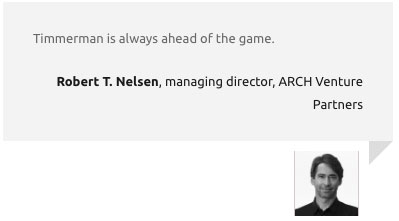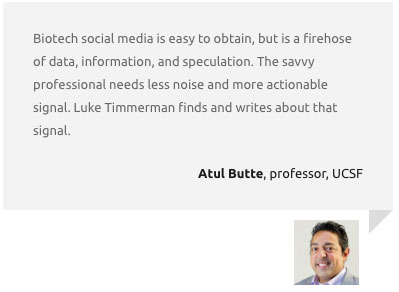Scientists Standing Up in Seattle

Arjun Kumar
Several thousand scientists gathered Friday in Seattle for one of the nationwide “Stand Up for Science” protests. People studying a range of disciplines — biology, climate change, public health and more — took a break from the lab to protest cuts to federal spending on science and mass firings.
Morale had been low for weeks among many attendees, but Friday had a different mood. Scientists and their allies of all ages gathered on the amphitheater grass under a rare sunny Seattle day.
Speakers stood below the iconic Space Needle and drew thunderous applause. Some wore white lab coats while others waved American flags. Many brought their dogs. Two protestors even dressed in chicken costumes, calling attention to the rising outbreak of bird flu in the U.S.
Despite the lighter aspects, participants had a serious purpose. Carrying signs with messages like “Science Saves Lives”, “No Science, No Cures”, and “Dump DOGE, Defend Our Data”, they had three core policy demands:
- An end to censorship and political interference in science, including removing restrictions on research topics eligible for federal funding and restoring public access to scientific data scrubbed from federal websites
- Restoration of federal research funding, including removal of the 15% cap on indirect funding for NIH grants, and reinstatement of wrongfully dismissed federal employees
- Preservation of diversity, equity, inclusion, and accessibility programs in Science, Technology, Engineering, and Math, including enforcement of anti-discrimination protections for minority scientists
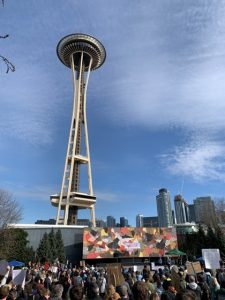
Protestors at Space Needle on Friday, March 7 (Photo by Arjun Kumar)
Chetan Seshadri, a tuberculosis researcher at the University of Washington, described the NIH funding cuts in material terms. He’d initially declined the speaking invitation from the rally organizers until the NIH grant review panel he was scheduled to participate in was abruptly canceled.
“We’ve been told it’s about budgets,” he said. “If it was about budgets, they wouldn’t have canceled my nonrefundable flight.”
Seshadri pointed to the NIH’s proposal to cap indirect costs on grants at 15% as particularly impactful for researchers. For example, the University of Washington doesn’t own the building that houses his lab and instead pays rent through a high indirect cost rate. The proposed change to indirect costs would lead to an estimated $90 million loss for the university.
The UW secures more federal research dollars than any other US public university. Now, with grant funding withheld and grant review panels canceled, Seshadri said he’s worried about making payroll for his lab.
Many of the cuts to federal agencies are being challenged in court. Washington Gov. Bob Ferguson expressed his support and described lawsuits the state has joined. He expressed confidence in the ongoing lawsuits, pointing to his record as the state’s Attorney General when he won 58 cases while losing 3 against the first Trump Administration. That line drew cheers.
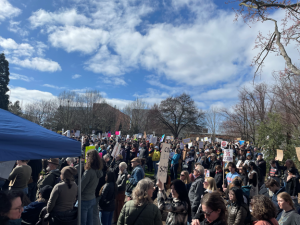
Stand Up for Science in Seattle. Mar. 7. (Photo by Kelsey Woodruff).
A look at the audience, however, revealed mixed support for the Washington Governor, who has proposed $4 billion in cuts to the state budget after inheriting a deficit. Signs like “Bob focus on the revenue” and “Furloughs are BAD for Science!” criticized the governor’s proposal to furlough state employees (including public university workers) to address an estimated $15 billion state budget shortfall.
In a nod to conservatives, pediatric oncologist Jim Olson of Seattle Children’s Hospital described growing up and “pulling himself up by the bootstraps.” He finished college in three years while simultaneously working and being supported by federal Pell Grants for low-income students. Olson earned his MD/PhD at the University of Michigan (again with the support of federal funding) before becoming a leading researcher of brain cancer in children.
Federal research funding fueled his work, and it eventually translated into his co-founding of three biotech companies — Presage Biosciences, Blaze Bioscience, and Link Immunotherapeutics. Those companies collectively raised over $200 million in venture capital and created dozens of high-paying jobs.
Government and industry each have roles to play, Olson said. Government, he said, “is intended to do what companies cannot do” – including supporting the training of young scientists.
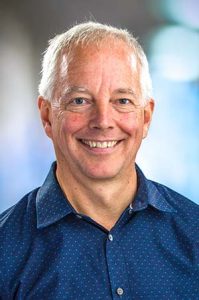
Jim Olson, professor, Seattle Children’s Research Institute; program director, Invent@SC
Many such trainees have felt heightened anxieties because of these cuts. I ran into a friend, a first-year graduate student, who was rotating between professors to choose a permanent lab. There aren’t many choices, as few professors have enough funding flexibility to accept a new student.
As a third-year graduate student working on immunotherapies, my own collaboration with the National Cancer Institute has also been effectively frozen, first by a ban on external communication from the Department of Health and Human Services and then by cuts to the NIH’s intramural research funding. Each of my classmates has a similar story.
Many people were sharing their stories at the protest. An estimated 4,200 people attended the Seattle event alone, with sister rallies in over 30 U.S. cities and several other countries.
Kelsey Woodruff, a graduate student and one of the rally’s organizers, noted the event came together in just three weeks. She joined the organizing effort after feeling disillusioned with government and federal funding, saying “the rally felt like a place to put my frustration and anger in a productive way.” Woodruff wanted to “restore a sense of agency” and remind her fellow scientists and allies that “you can keep advocating for science and calling your representatives.” In a time when many feel powerless, she said this rally was one way to “feel like you can do something about it.”
Such advocacy was new to many scientists, with the recent turmoil inspiring them to write to their legislators for the first time.
But trying new things is itself a practice of science. As Seshadri said, “the founding fathers were scientists – political scientists – who tried something new. They didn’t know if it would last, and it’s now being put to the test.” The current administration, he said, “wants people to give up and look away.” It was time for people to “use their voice and speak truth to power.”
Arjun Kumar is a graduate student in Molecular & Cellular Biology at the University of Washington who participated in the rally.

